Do you struggle with pain, tenderness, or stiffness in your thumb joint that makes everyday tasks like gripping objects or using utensils challenging? If so, you may be among the many individuals who suffer from arthritis of the thumb. Arthritis of the thumb is a common condition that can have a significant impact on your daily life and quality of life. But, the good news is that at the Sydney Orthopaedic Surgeon Clinic, we offer expert care for those experiencing this condition.
Dr Stuart Kirkham, our qualified orthopaedic surgeon who benefits from over 25 years of experience, specialises in treating arthritis of the thumb. With his expertise and our team’s support, we provide personalised and effective treatment options to help alleviate your symptoms and improve your overall well-being. From conservative treatments like pain relief medications, splints, and corticosteroid injections to more advanced surgical procedures, we offer a range of solutions tailored to your needs.
We understand that living with arthritis of the thumb can be frustrating and challenging. That’s why Dr Stuart Kirkham is committed to providing you with the knowledge and support you need to make informed decisions about your health. He’ll take you through the causes, symptoms, diagnosis, and treatment options available for arthritis of the thumb, and also provide you with information about the prevention, aftercare, and potential complications that may arise. Whether your symptoms are mild or severe, don’t hesitate to reach out to us. We’re here to help you get back to living your life to the fullest. Contact our friendly team to schedule a consultation with Dr Kirkham at the Sydney Orthopaedic Surgeon Clinic.
Anatomy Related to Arthritis of the Thumb
The thumb joint is a complex structure that allows for various movements, including flexion, extension, abduction, and adduction. The joint is made up of three bones: the metacarpal bone in the palm of the hand, and two phalanges, or finger bones. The metacarpal bone connects to the proximal phalanx, and this connects to the distal phalanx, forming the entire thumb. The joint is surrounded by ligaments that hold the bones together and provide stability.
Cartilage plays a critical role in the function of the thumb joint. It is a firm, flexible tissue that covers the ends of bones in the joint and allows them to move against each other without causing damage. In the thumb joint, the cartilage is located on the metacarpal bone and the proximal phalanx.
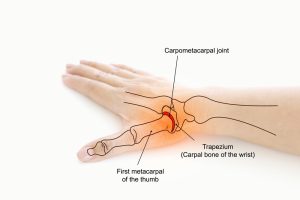
There are different types of arthritis that can affect the thumb joint, including osteoarthritis, rheumatoid arthritis, and post-traumatic arthritis. Osteoarthritis is the most common type and is caused by wear and tear of the cartilage in the joint over time. Rheumatoid arthritis is an autoimmune disease that causes inflammation in the joints, including the thumb joint. Post-traumatic arthritis can occur after an injury or fracture to the thumb, leading to damage to the cartilage and subsequent arthritis.
Understanding the anatomy of the thumb joint and the role of cartilage can help you better understand the causes and symptoms of arthritis of the thumb. If you are experiencing pain, swelling, or stiffness in your thumb joint, it’s essential to consult with an experienced orthopaedic surgeon like Dr Stuart Kirkham. At the Sydney Orthopaedic Surgeon Clinic, we have the expertise and resources to help diagnose and treat your condition effectively, so don’t hesitate to contact Dr Stuart Kirkham today for a consultation.
Causes and Risk Factors for Arthritis of the Thumb
Arthritis of the thumb is a common condition that can occur due to a combination of factors, including aging, genetics, previous injuries, medical conditions, and lifestyle factors.
As we age, the cartilage that cushions the bones can become damaged or worn down simply as a result of wear and tear. This can lead to the development of osteoarthritis, the most common type of arthritis affecting the thumb joint. As a result, thumb arthritis occurs most commonly in men and women typically over the age of 50.
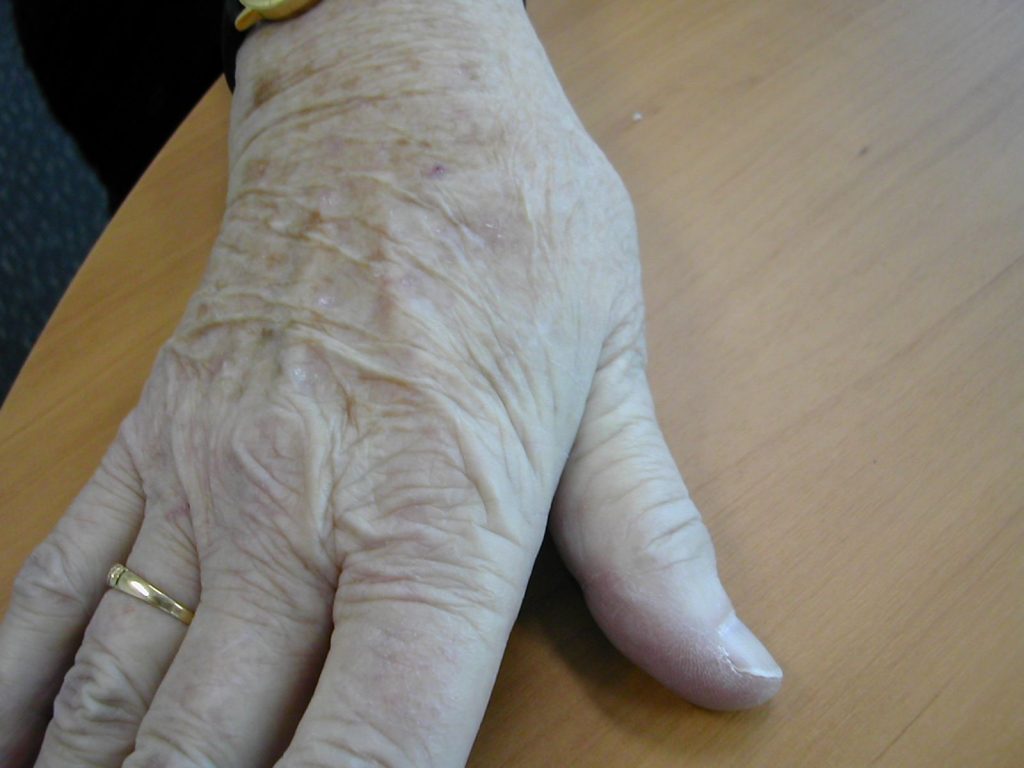
However, it’s important to know that genetics can also play a role in the development of arthritis of the thumb. If a family member has had arthritis, you may be more likely to develop it yourself. Additionally, some genetic conditions can cause arthritis to develop earlier in life.
Previous injuries to the thumb joint, such as fractures or sprains, can also increase the risk of developing arthritis. These injuries can cause damage to the cartilage and bone which leads to the development of post-traumatic arthritis. Furthermore, medical conditions such as rheumatoid arthritis, psoriatic arthritis, and gout can also affect the thumb joint and lead to the development of arthritis.
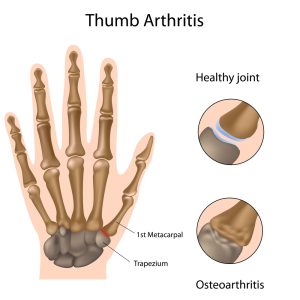
Finally, lifestyle factors such as repetitive use of the thumb joint, especially with force or awkward postures, can contribute to the development of arthritis. Individuals who engage in activities such as knitting, sewing, or manual labour that require constant use of the thumb joint may be at an increased risk.
It’s essential to understand the causes and risk factors associated with arthritis of the thumb to take preventative measures and seek early treatment if necessary. At the Sydney Orthopaedic Surgeon Clinic, Dr Stuart Kirkham is determined to help you identify the underlying cause of your arthritis and provide personalised treatment options. Regardless of your individual circumstances, we’re committed to optimising your thumb health and getting you back on track.
Symptoms and Identification of Arthritis of Thumb
Arthritis of the thumb can cause a range of symptoms that can impact one’s daily life. The primary symptom of arthritis within the thumb is simply pain and tenderness at the base of the thumb. Typically, this pain is exacerbated by activities that require the use of the joint, such as grasping, gripping, or twisting motions. While this pain can be mild to severe, it may also be accompanied by stiffness, making it difficult to move the thumb joint.
Arthritis of the thumb can also lead to swelling and inflammation in the joint, which can cause the affected area to feel warm or tender to the touch. This might also result in changes in the appearance of the thumb, making it appear red or puffy. Another common symptom of thumb arthritis is a decreased range of motion, which can make it difficult to perform everyday tasks such as opening jars or turning doorknobs.
As arthritis progresses, it can lead to the development of bone spurs, small bony growths that can cause additional pain, swelling, and stiffness in the affected joint. In more severe cases, arthritis of the thumb can also cause weakness and numbness in the fingers, indicating nerve compression.
If you have been experiencing any of these symptoms, it’s important to seek medical attention to determine the underlying cause and find the appropriate treatment. Dr Stuart Kirkham from the Sydney Orthopaedic Surgeon Clinic can assist you with expert evaluations and tailored management plans for your symptoms, helping you relieve your pain and regain function in the affected joint.
Diagnosis and Imaging of Arthritis of Thumb
Diagnosing arthritis of the thumb typically involves a combination of a physical examination and imaging techniques. During a physical examination, a qualified medical professional, such as Dr Stuart Kirkham from the Sydney Orthopaedic Surgeon Clinic, will evaluate the affected area, looking for any swelling, tenderness, or other abnormalities.
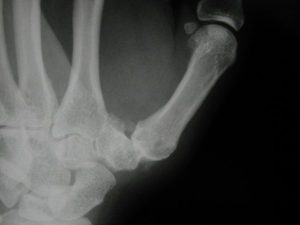
X-rays are a commonly used imaging technique to diagnose arthritis of the thumb, as they can provide detailed images of the bones and joints in the hand. These forms of imaging are also favoured as they can show any changes or abnormalities in the bones, including bone spurs or thinning of the joint space.
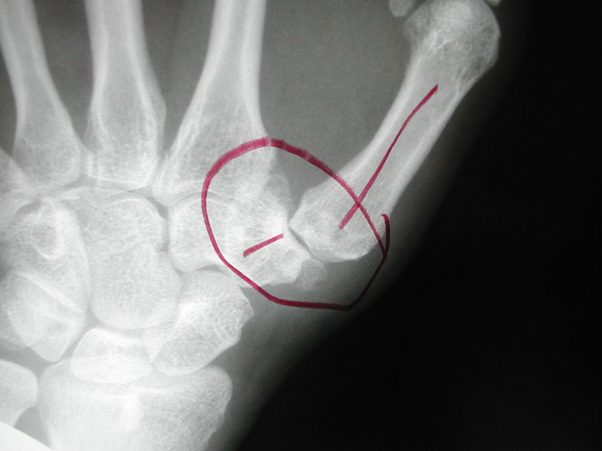
Magnetic Resonance Imaging (MRI) is another imaging technique that may be used to diagnose arthritis of the thumb. This technique provides detailed images of the soft tissues in the hand, including cartilage, ligaments, and tendons. MRIs can identify the early signs of arthritis and detect any soft tissue damage that may have occurred.
Blood tests are not typically used to diagnose arthritis of the thumb, but they may be ordered to rule out other conditions that can cause joint pain, such as rheumatoid arthritis or gout.
However, it’s important to note that while Dr Kirkham does use these forms of medical imaging, his primary focus is to treat the patient, not simply the X-ray. He understands that the pain you are experiencing cannot be adequately represented by an image, and that’s why the main focus at the Sydney Orthopaedic Surgeon Clinic is to provide a personalised treatment plan that works for the individual and adequately manages their pain. With this specialised medical advice, you’ll be on your way to recovery and working towards restoring the function of your thumb.
Treatment Options for Arthritis of Thumb
When it comes to treating arthritis of the thumb, there are several options available depending on the severity of the condition. At the Sydney Orthopaedic Surgeon Clinic, Dr Stuart Kirkham offers a range of treatment options to help you find relief and get back to your daily activities without pain or discomfort.
Conservative treatments are often the first line of defence for mild to moderate cases of arthritis of the thumb. These include pain relief medications, such as nonsteroidal anti-inflammatory drugs (NSAIDs), which can help alleviate pain and reduce inflammation. In addition to medication, splints can be used to limit movement of the affected thumb joint, which can reduce pain and improve function. In some cases, corticosteroid injections may also be recommended to reduce inflammation and relieve pain.
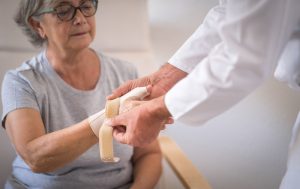
Physical therapy and occupational therapy are also effective non-surgical options for treating arthritis of the thumb. These therapies can help improve the range of motion, reduce pain, and increase strength and flexibility in the affected joint. A physical therapist will work with you to develop an exercise plan tailored to your individual needs, while an occupational therapist can help you make modifications to your daily activities to reduce stress on the affected joint.
In some cases, surgical intervention may be necessary to treat arthritis of the thumb. The treatment approach that Dr Stuart Kirkham uses will depend on the severity of the condition and the affected joints.
For arthritis of the carpometacarpal joint (CMCJ), a pyrocarbon resurfacing implant called Pyrocardan is Dr Kirkham’s first preference. These disc-shaped implants are designed to replace the damaged cartilage with a durable and long-lasting pyrocarbon material that can help restore function to the joint.
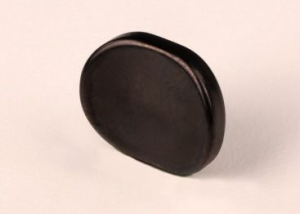
For arthritis of the scaphotrapeziotrapezoidal joint (STTJ), a pyrocarbon resurfacing implant called STPI implant is the preferred option. This implant is designed to replace the damaged joint surface with a smooth pyrocarbon material that can help reduce pain and improve function.
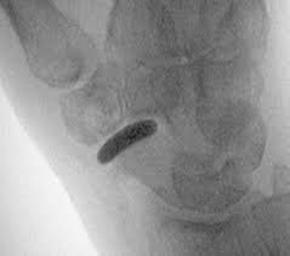
If both the CMCJ and STTJ are affected, a trapeziectomy may be recommended. This procedure involves the removal of the trapezium bone in the wrist and can help alleviate pain and restore function to the affected joint.
Dr Kirkham will work with you to determine the best course of action based on your individual needs and the severity of your condition. Surgical options are generally reserved for more severe cases of arthritis of the thumb that has not responded to conservative treatments.
Regardless of the treatment approach, the goal of treatment is to reduce pain and improve function in the affected joint. With the right treatment plan, most patients can achieve significant improvement in their symptoms and quality of life. Contact the Sydney Orthopaedic Surgeon Clinic today to schedule a consultation with Dr Kirkham and learn more about your treatment options for arthritis of the thumb.
Prevention and Aftercare for Arthritis of the Thumb
Arthritis of the thumb can cause significant discomfort and limit a person’s ability to perform daily activities. Fortunately, there are steps individuals can take to reduce the risk of developing arthritis in the thumb or minimise its severity.
One of the most effective ways to prevent arthritis of the thumb is to make lifestyle modifications that reduce the risk of wear and tear on the joint. These may include avoiding repetitive motions or overuse of the thumb joint, maintaining a healthy weight, and protecting the thumb from injury.
Ergonomics and adaptive tools can also play a significant role in reducing the risk of arthritis of the thumb. Individuals can make changes to their work or home environment to reduce the strain on the thumb joint. This may involve using ergonomic keyboards, changing the layout of the workspace, or using adaptive tools to perform tasks that require gripping or grasping.

Regular exercise and stretching can help maintain joint health and prevent the development of arthritis in the thumb. Exercises that target the thumb joint, such as thumb stretches, can help improve flexibility and reduce stiffness. Strength training exercises for the hand and wrist can also help build the muscles around the joint, providing additional support.
Aftercare following treatment for arthritis of the thumb is crucial to ensure a full and speedy recovery. This may involve rest, physical therapy, or the use of splints or braces to support the affected joint during the healing process. Regular follow-ups and monitoring can also help identify any new symptoms or complications and allow for prompt treatment.

Ultimately, prevention and aftercare are critical for individuals experiencing arthritis of the thumb. Taking steps to reduce the risk of developing the condition and following the recommended treatment plan can help alleviate symptoms and improve quality of life. Dr Stuart Kirkham from the Sydney Orthopaedic Surgeon Clinic can provide expert guidance and support for preventing and managing arthritis of the thumb. Contact us today to schedule a consultation and learn more about how we can help you find relief from your symptoms.
The Recovery Process for Arthritis of the Thumb
Recovering from arthritis of the thumb can be a challenging process, but with the right treatment and support, it’s possible to regain full function of the affected joint. The recovery timeline will depend on the type of treatment received and the severity of symptoms.
If non-surgical treatments, such as medication or splinting, are successful, most patients will be able to return to their normal activities within a few days to a week. However, it’s important to avoid any activities that may cause irritation or reinjury to the affected joint.
In cases where surgical intervention is necessary, recovery will take longer, and a period of rest and rehabilitation is essential. Dr Stuart Kirkham from the Sydney Orthopaedic Surgeon Clinic will provide you with detailed instructions on post-operative care and rehabilitation exercises to promote healing and restore range of motion. However, the postoperative recovery process does not have one standard timeframe, as some people will be comfortable within days while for others it might take weeks.
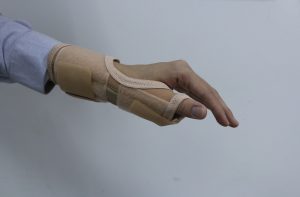
Physical therapy and rehabilitation exercises are an important part of the recovery process, helping to improve the range of motion, restore muscle strength, and promote healing. Dr Kirkham will provide you with a customised rehabilitation plan tailored to your individual needs and recovery goals.
Managing pain and swelling is also an essential aspect of the recovery process. You may be advised to use ice or heat therapy, take over-the-counter pain medication, or use a compression bandage to reduce pain and swelling.

Returning to normal activities will depend on the type of treatment you received and the severity of your symptoms. Dr Kirkham will provide you with specific guidelines regarding when you can resume certain activities, such as sporting activities or heavy lifting, to avoid reinjury or exacerbation of symptoms.
With expert care and support from Dr Kirkham and his team at the Sydney Orthopaedic Surgeon Clinic, you can achieve optimal joint health and return to your normal daily activities as quickly and safely as possible. Contact us today to schedule a consultation and learn more about how we can help you find relief from your symptoms and improve your quality of life.
Possible Complications of Arthritis of the Thumb
As with any medical condition or treatment, there is always a risk of potential complications. Although rare, it’s important to be aware of possible complications that can occur following treatment for arthritis of the thumb.
One potential complication is an infection, which can develop at the site of the surgery or around any implants that may have been inserted. Signs of infection include redness, swelling, warmth, pain, and fever. If you experience any of these symptoms, it’s important to contact Dr Stuart Kirkham from the Sydney Orthopaedic Surgeon Clinic promptly, as treatment with antibiotics may be necessary to prevent the infection from spreading.
Nerve damage is another possible complication that can occur with arthritis of the thumb. This can happen if nerves are inadvertently damaged during surgery, leading to symptoms such as tingling, numbness, or weakness in the affected area. In most cases, nerve damage is temporary and resolves over time, but it can occasionally be permanent.
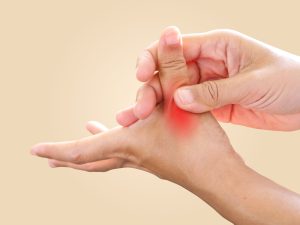
Implant failure or complications can occur in cases where joint replacement surgery has been performed. Although rare, implants can become dislocated, break, or cause problems with neighbouring structures. If you experience any new or worsening symptoms following joint replacement surgery, it’s important to seek medical attention immediately.
Recurrence of arthritis can also occur, especially if the underlying cause of the arthritis has not been addressed. This may result in the need for further treatment, including additional surgeries or other interventions to manage symptoms and prevent further joint damage.
Although these complications are possible, it’s important to remember that they are rare, and most patients experience a successful outcome following treatment for arthritis of the thumb. Dr Stuart Kirkham from the Sydney Orthopaedic Surgeon Clinic has extensive experience in the diagnosis and treatment of arthritis of the thumb and can provide expert care and support to help you achieve optimal joint health and function.
Are You Concerned About Arthritis of the Thumb?
If you are experiencing symptoms of arthritis of the thumb, it’s important to seek medical attention from a qualified orthopaedic surgeon. Dr Stuart Kirkham from the Sydney Orthopaedic Surgeon Clinic is an expert in the diagnosis and treatment of arthritis of the thumb, and he can help you find relief from your symptoms and get back to your normal daily activities.
Early diagnosis and treatment are crucial for preventing further damage to the joint and ensuring a full recovery. If left untreated, arthritis of the thumb can cause significant pain, stiffness, and limitation in function, which can negatively impact your quality of life.

Dr Kirkham offers personalised treatment plans tailored to your individual needs and goals, whether it be conservative treatments such as pain relief medications, splints or corticosteroid injections, or more advanced surgical options such as joint fusion, joint replacement or ligament reconstruction.
Don’t let arthritis of the thumb hold you back any longer. Contact the Sydney Orthopaedic Surgeon Clinic today to schedule a consultation with Dr Kirkham and learn more about your treatment options.
Frequently Asked Questions
1. Can arthritis of the thumb be prevented?
While arthritis of the thumb cannot always be prevented, there are steps you can take to reduce your risk. Maintaining a healthy weight, avoiding repetitive motions, and protecting the joint from injury can all help to reduce your chances of developing arthritis in the thumb. Additionally, regular exercise and stretching can help to maintain good joint health and flexibility.
2. How is arthritis of the thumb diagnosed?
Diagnosis of arthritis of the thumb typically involves a physical examination by a qualified medical professional, such as Dr Stuart Kirkham from the Sydney Orthopaedic Surgeon Clinic. Imaging techniques, such as X-rays or magnetic resonance imaging (MRI), may also be used to confirm the diagnosis and assess the severity of the condition.
3. What are the treatment options for arthritis of the thumb?
Treatment options for arthritis of the thumb depend on the severity of the condition and may include conservative treatments such as pain relief medication, splints, and corticosteroid injections. Physical therapy and occupational therapy can also be effective for maintaining joint health and managing symptoms. Surgical options, such as joint fusion, joint replacement, or ligament reconstruction, may be necessary for more severe cases.
4. What is the recovery process like after surgery for arthritis of the thumb?
Recovery from surgery for arthritis of the thumb can take several weeks to several months, depending on the type of surgery and the individual’s recovery progress. Following the post-operative care instructions provided by Dr Kirkham is critical for a successful recovery. This may involve rest, physical therapy, and rehabilitation exercises to promote healing and restore range of motion.
5. What can I expect in terms of aftercare and follow-up appointments for arthritis of the thumb?
Following treatment for arthritis of the thumb, it’s important to follow Dr Kirkham’s aftercare instructions to ensure a full and speedy recovery. Regular follow-up appointments and monitoring can help to ensure that the condition does not recur or worsen over time. It’s important to maintain good joint health through regular exercise, stretching, and ergonomics to minimise the risk of developing future complications.
References
- Mayo Clinic (Thumb Arthritis)
- Ortho Info (Arthritis of the Thumb)
- American Society For Surgery of the Hand (Thumb Arthritis)
- Yale Medicine (Thumb Arthritis)


